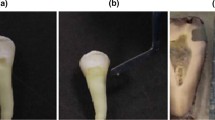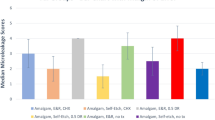Abstract
Purpose
Evaluate the influence of different surface treatment protocols on the bond strength of bulk fill restorative material to root dentin using the push-out test after cyclic loading.
Materials and methods
Forty intact human premolars, freshly extracted for orthodontic purpose with straight canals and fully developed apices, were selected for this study. The coronal portion of the teeth were cut perpendicular to the long axis of the teeth at the cement-enamel junction. All root canals were instrumented, cleaned, and obturated; then, a space of 3 mm in depth was prepared below the orifice level in both canals in each tooth to receive direct core bulk fill material; the specimens were classified according to the surface treatment protocol into four groups (n = 30). Group 1: no surface treatment (control group); group 2: surface treatment using Er,Cr:YSGG laser; group 3: surface treatment using chlorhexidine; and group 4: surface treatment using 17% EDTA solution. Restorations were bonded using universal adhesive following the same protocol. The roots were sectioned and three 1-mm-thick slices were obtained representing the length of the restorations inside the canals. The specimens were thermocycled, then subjected to push-out testing. A specimen from each group was examined using scanning electron microscope. Data was analyzed statistically using Kruskal-Wallis test and pairwise comparisons were carried out.
Results
The results showed that laser group was significantly higher than EDTA and chlorhexidine groups, and also higher than the control group with no significant difference. Also, the control group was significantly higher than EDTA and chlorhexidine group. However, chlorhexidine group was higher than EDTA group with no significant difference recorded (p < 0.05).
Conclusions
Er,Cr:YSGG laser showed promising results in terms of bond strength to radicular dentin. But still the control group using universal adhesive can provide comparable and satisfactory results.





Similar content being viewed by others
References
Carlos BP, Nalnan TM, Rose R (2013) Restoration of endodontically treated molars using all ceramic endocrowns. Case Rep Dent 2013:1–5
Stock CJR, Walker RT, Gulabivala K (2004) Endodontics (3rd ed). Elsevier Mosby, Edinburgh, pp 279– 305
Robbins JW (2001) Restoration of endodontically treated teeth. In: Summit JB, Williams Robbins J, Hilton TJ, Schwartz RS (eds) Fundamentals of operative dentistry: a contemporary approach. Quintessence Publishing Co Inc, Chicago, pp 546–566
Lasilla LVJ, Tamer J, Lebell AM, Narva K, Vallitu PK (2004) Flexural properties of fiber reinforced root canal posts. Dent Mater 20:29–36
Heydecke G, Butz F, Strub JK (2001) Fracture strength and survival rate of endodontically treated maxillary incisors with approximal cavities after restoration with different post and core systems: an in-vitro study. J Dent 29:427–433
Sidoli GE, King PA, Setchell DJ (1997) An in vitro evaluation of a carbon fiber-based post and core system. J Prosthet Dent 78(1):5–9
Schneider SW (1971) A comparison of canal preparations in straight and curved root canals. Oral Surg Oral Med Oral Pathol 32:271–275
Hayashi M, Takahashi Y, Hirai M, Iwami Y, Imazato S, Ebisu S (2005) Effect of endodontic irrigation on bond- ing of resin cement to radicular dentin. Eur J Oral Sci 113(1):70–76
Baena E, Flores A, Ceballos L (2017) Influence of root dentin treatment on the push-out bond strength of fiber posts. Odontology 105(2):170–177
Yavari HR, Rahimi S, Shahi S, Lotfi M, Barhaghi MHS, Fatemi A, Abdolrahimi M (2010) Effect of Er,Cr:YSGG laser irradiation on Enterococcus faecalis in infected root canals. Photomed Laser Surg 28:S91–S96
Santos J, Carrilho M, Tervahartiala T, Sorsa T, Breschi L, Mazzoni A, Pashley D, Tay F, Ferraz C, Tjäderhane L (2009) Determination of matrix metalloproteinases in human radicular dentine. J Endod 35:686–689
Gomes FM, Vaneli RC, Conti Cde M, Basting RT, Amaral FL, Turssi CP (2015) Effect of chlorhexidine and ethanol application on long-term push-out bond strength of fiber posts to dentin. J Contemp Dent Pract 16(7):547–553
Neslihan Ç, Emine K, Devrim K, Murat A, Serkan S (2016) Influence of the ER,CR:YSGG laser and different irrigation methods on push-out bond strength of fiber post. J Adhes Sci Technol 2016 30(11):1178–1188
Bouillaguet S, Troesch S, Wataha JC, Krejci I, Meyer JM, Pashley DH (2003) Microtensile bond strength between adhesive cements and root canal dentin. J Dent Mater 19(3):199–205
Lopes GC, Ballarin A, Baratieri LN (2012) Bond strength and fracture analysis between resin cements and root canal dentine. Aust Endod J 38(1):14–20
Kenshima S, Francci C, Reis A, Loguercio AD, Filho LE (2006) Conditioning effect on dentin, resin tags and hybrid layer of different acidity self-etch adhesives applied to thick and thin smear layer. J Dent 34(10):775–783
Sudsangiam S, Noort VR (1999) Do Dentin bond strength test serve a useful purpose? J Adhes Dent 1:57–67
Ohlmann B, Fickenscher F, Dreyhaupt J et al (2008) The effect of two luting agents, pretreatment of the post, and pretreatment of the canal dentin on the retention of fiber-reinforced composite posts. J Dent 36:87–92
Love RM, Jenkinson HF (2002) Invasion of dentinal tubules by oral bacteria. Crit Rev Oral Biol Med 13:171–183
Guidotti R, Merigo E, Fornaini C, Rocca JP, Medioni E, Vescovi P (2014) Er:YAG 2940 nm laser fiber in endodontic treatment: a help in removing smear layer. Lasers Med Sci 29:69–75
Ribeirro AD, Nogueira GEC, Antoniazzi JH et al (2007) Effects of diode laser (810 nm) irradiation on root canal walls: Thermographic and morphological studies. J Endod 33:252–255
Lambriandis T, Kosti E, Mazinis M (2006) Removal efficacy of various calcium hydroxide/chlorohexidine medicaments from root canal. Int Endod J 39:55–61
Aksornmuang J, Nakajima M, Foxton RM, Tagami J (2008) Regional bond strength and failure analysis of fiber posts bonded to root dentin. J Operative Dent 33:636–643
Bravo C, Sampaio C, Hirata R, Puppin-Rontani RM, Mayoral JR, Giner L (2017) In-vitro comparative study of the use of 2% chlorhexidine on microtensile bond strength of different dentin adhesives: a 6 months evaluation. Int J Morphol 35(3):893–900
De Munck J, Mine A, Van den Steen PE, Van Landuyt KL, Poitevin A, Opdenakker G, Van Meerbeek B (2010) Enzymatic degradation of adhesive-dentin interfaces produced by mild self-etch adhesives. Eur J Oral Sci 118(5):494–501
Nelamakanahalii KS, Kukkalii KS, Reddy SVV (2017) Effect of dentin disinfection with 2% chlorhexidine gluconate and 0.3% iodine on dentin bond strength: an in vitro study. Int J Clin Pediatr Dent 10(3):223–228
Pisani-Proenca J, Erhardt MC, Amaral R, Valandro LF, Bottino MA, Del Castillo-Salmeron R (2011) Influence of different surface conditioning protocols on microtensile bond strength of self-adhesive resin cements to dentin. J Prosthet Dent 105:227–235
Author information
Authors and Affiliations
Corresponding author
Ethics declarations
Conflict of interest
The authors declare that they have no conflict of interest.
Ethical approval
This study does not include any human participants or animals. It was conducted on anonymous extracted teeth.
Additional information
Publisher’s note
Springer Nature remains neutral with regard to jurisdictional claims in published maps and institutional affiliations.
Rights and permissions
About this article
Cite this article
El Zayat, I., Ghobashy, A., Eldine, D.S. et al. Effect of different surface treatment protocols on bond strength to root dentin using bulk fill restorative material. Laser Dent Sci 4, 89–95 (2020). https://doi.org/10.1007/s41547-020-00095-7
Received:
Accepted:
Published:
Issue Date:
DOI: https://doi.org/10.1007/s41547-020-00095-7




